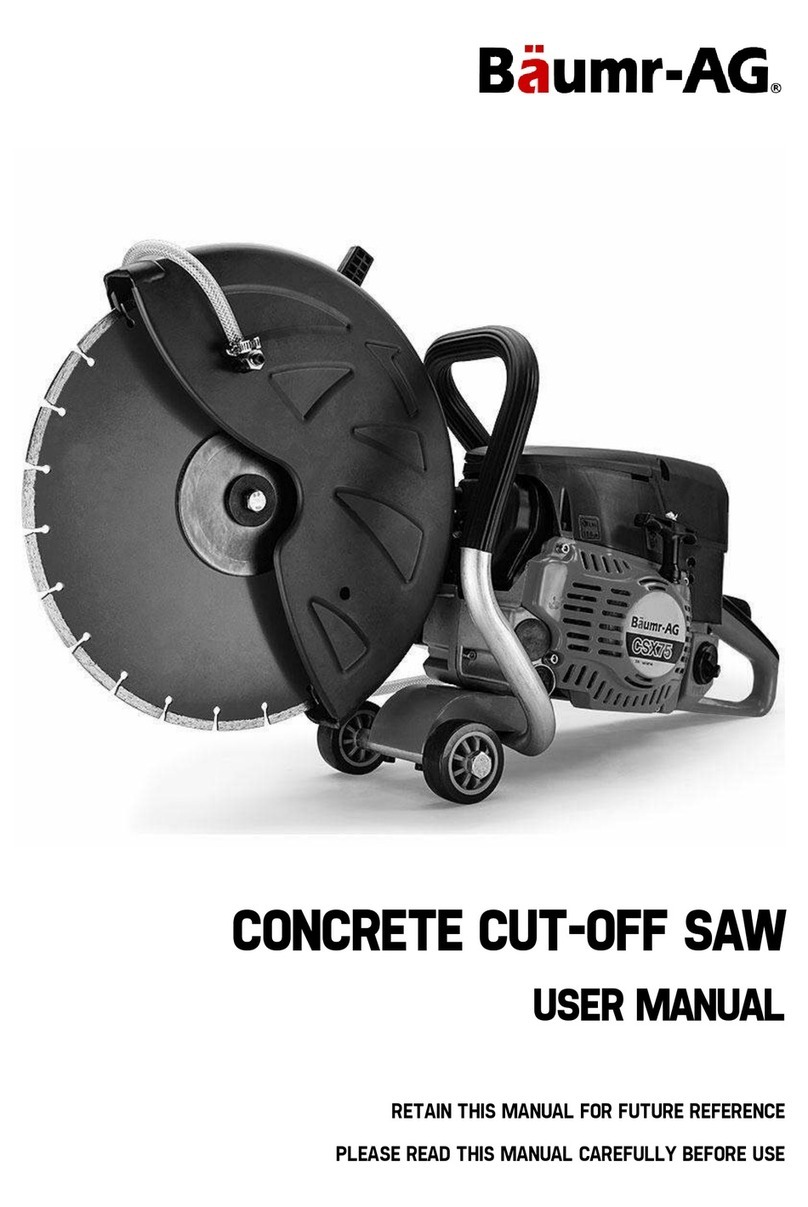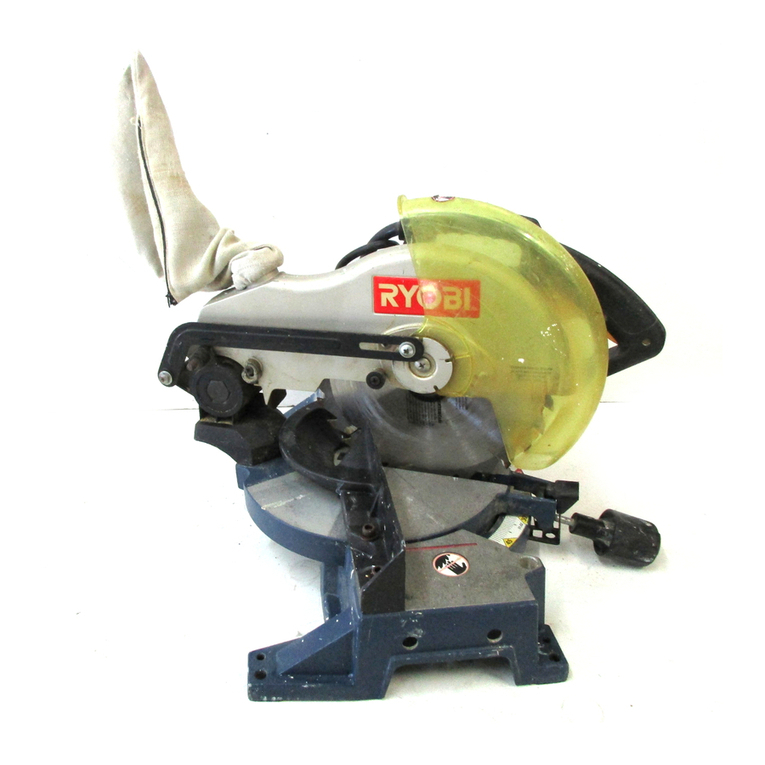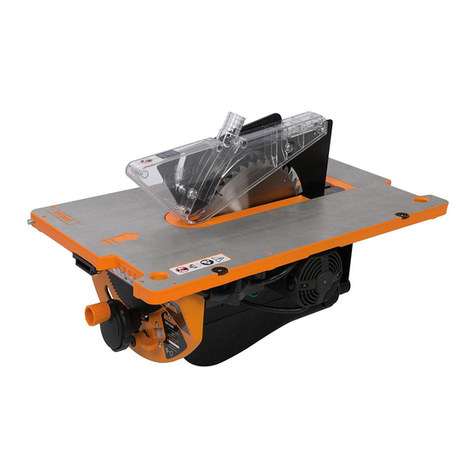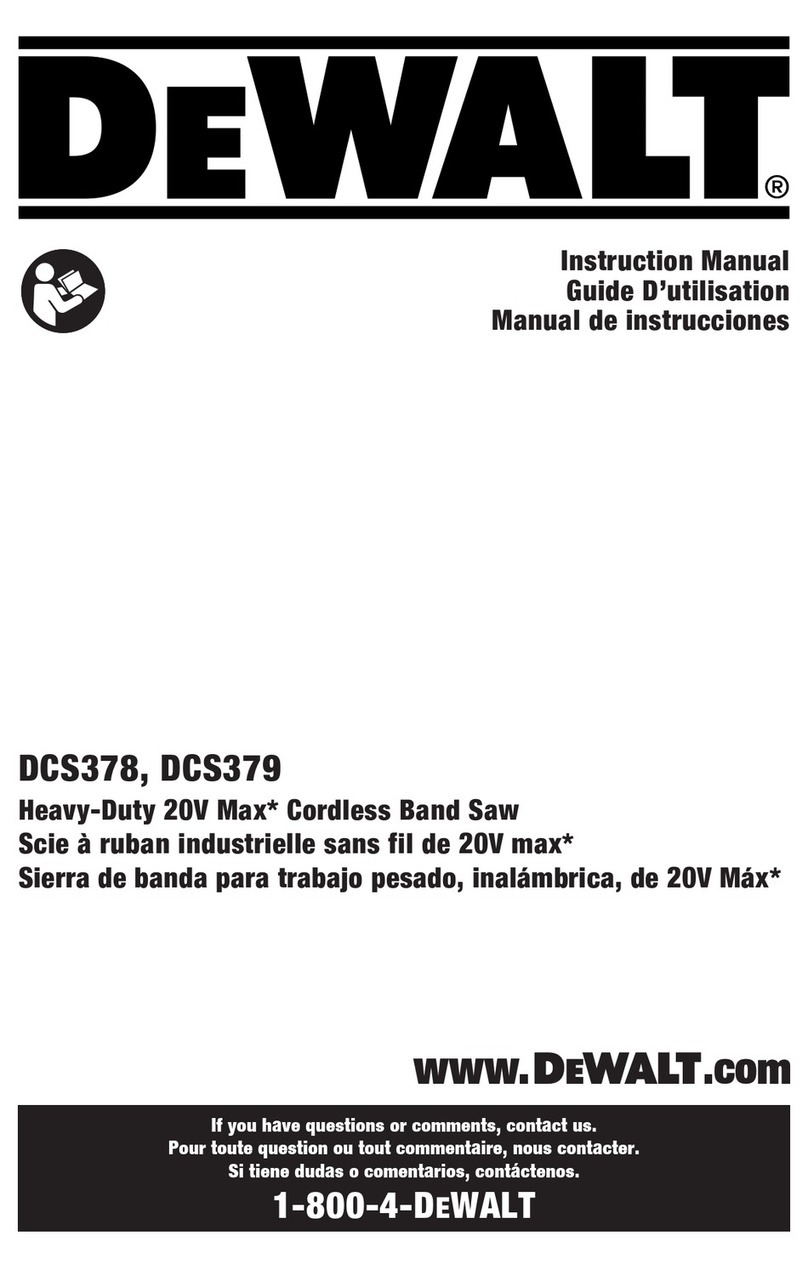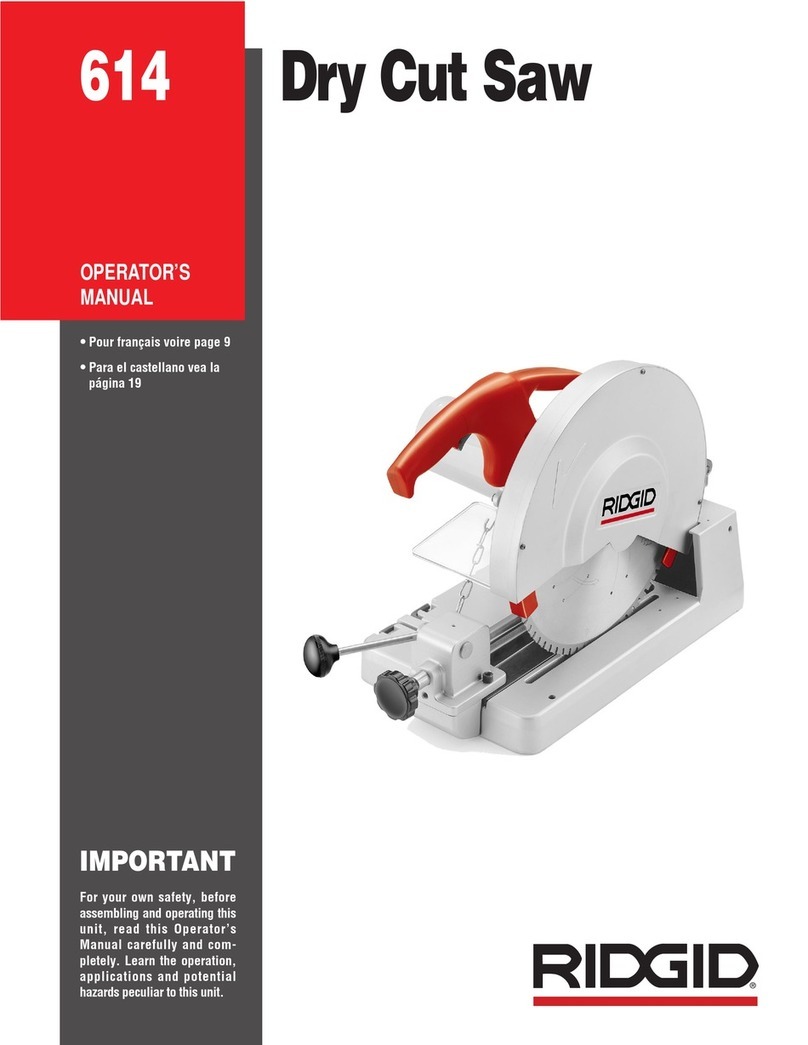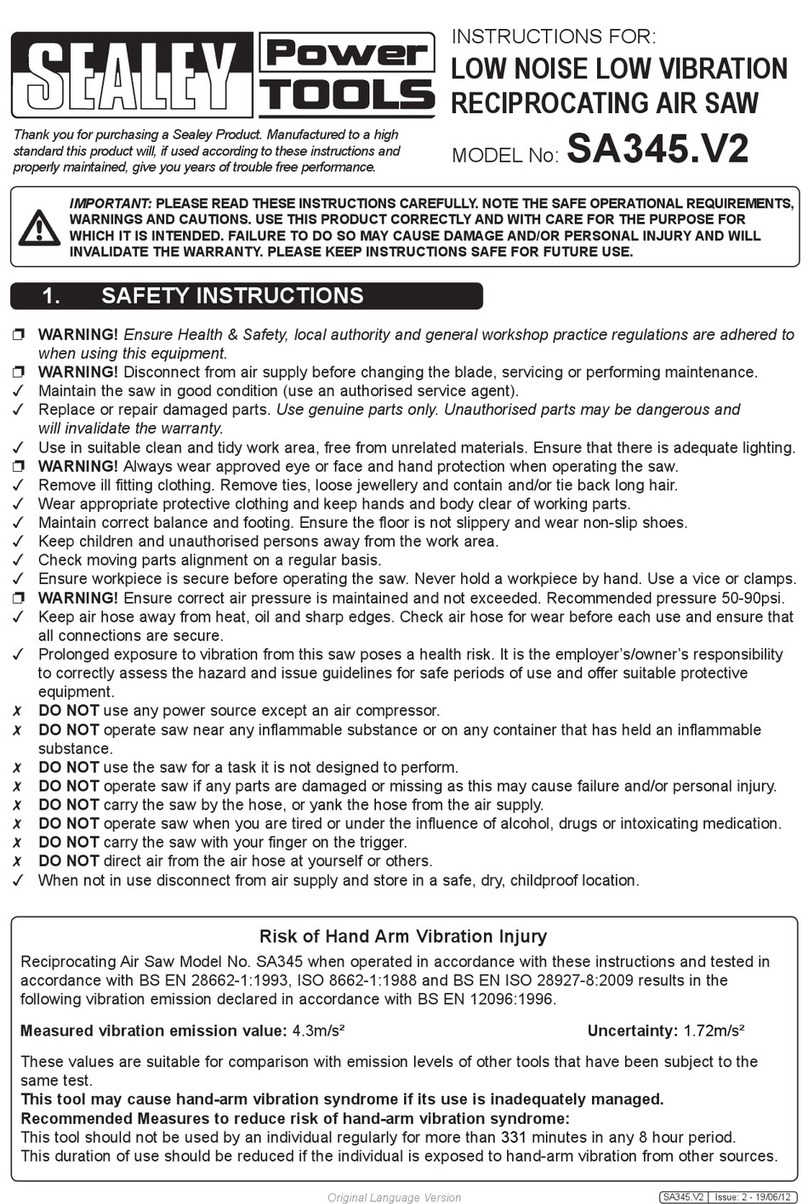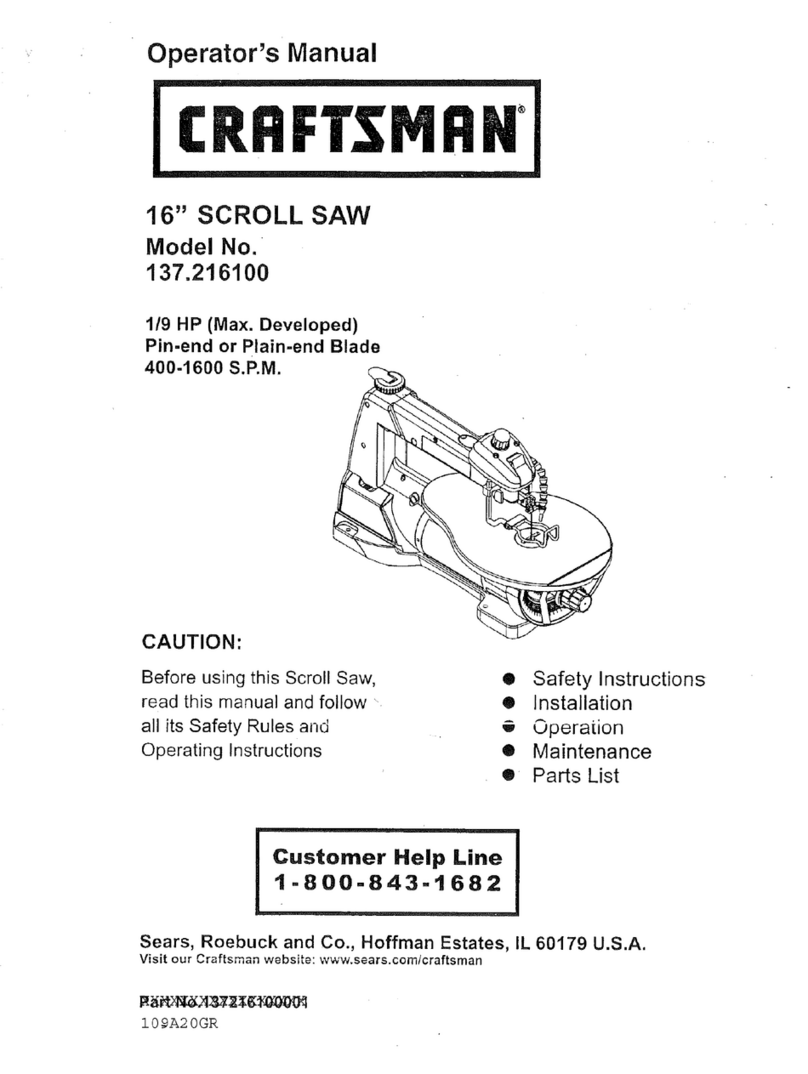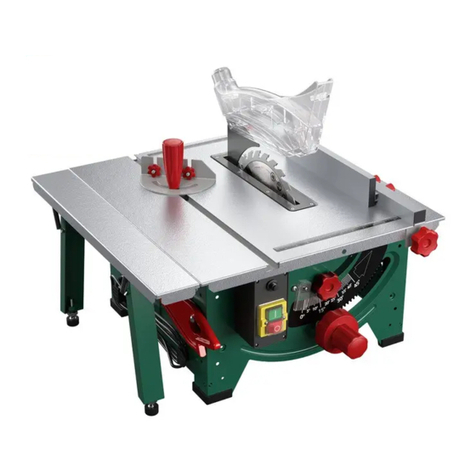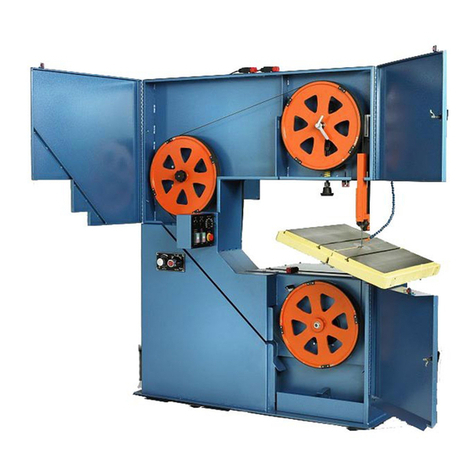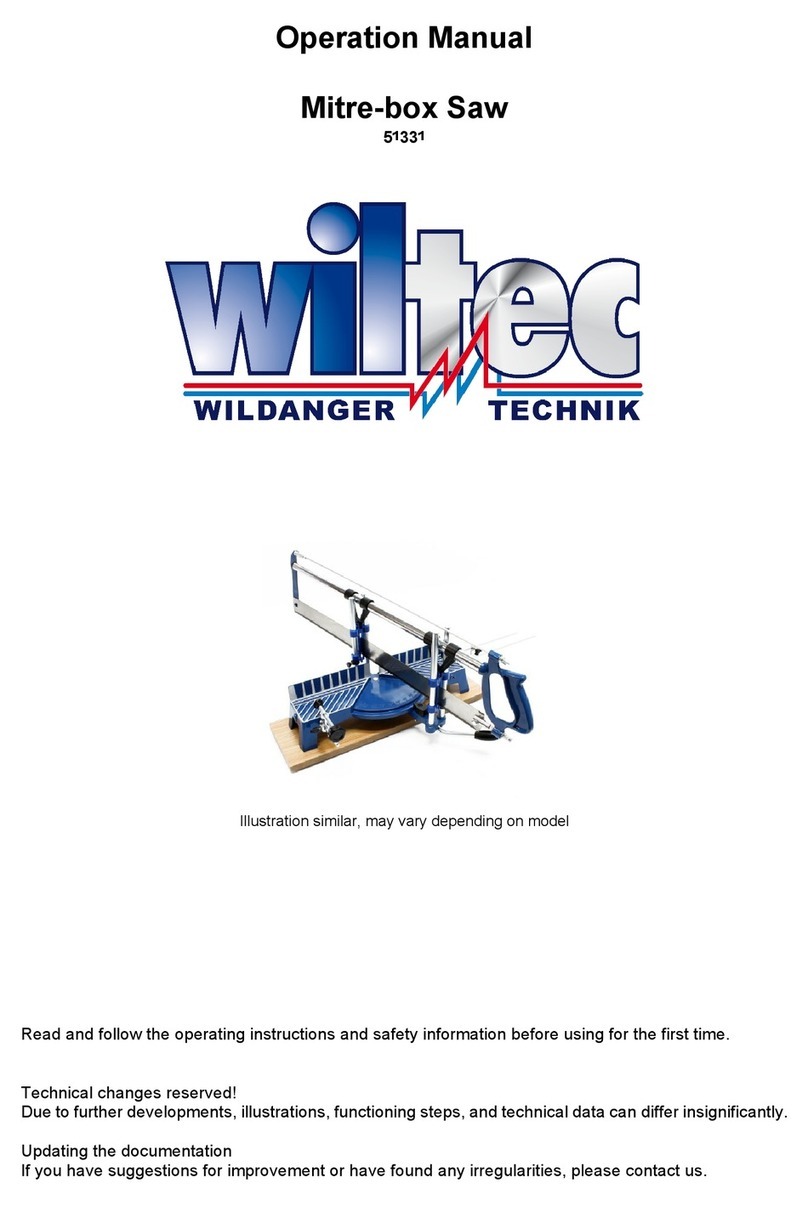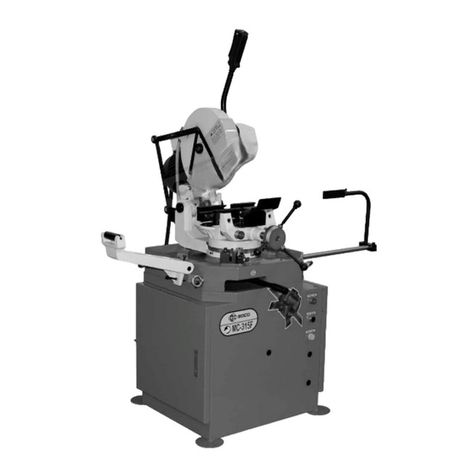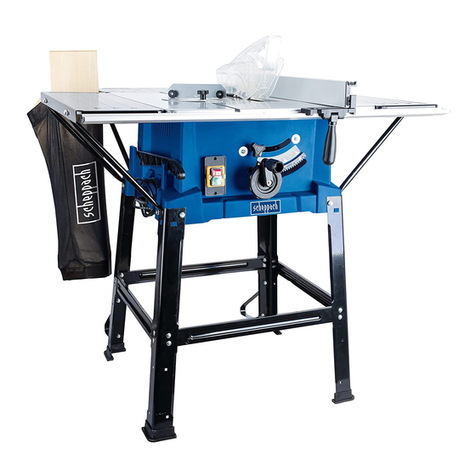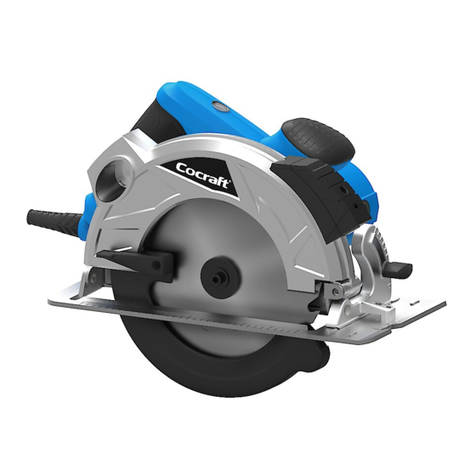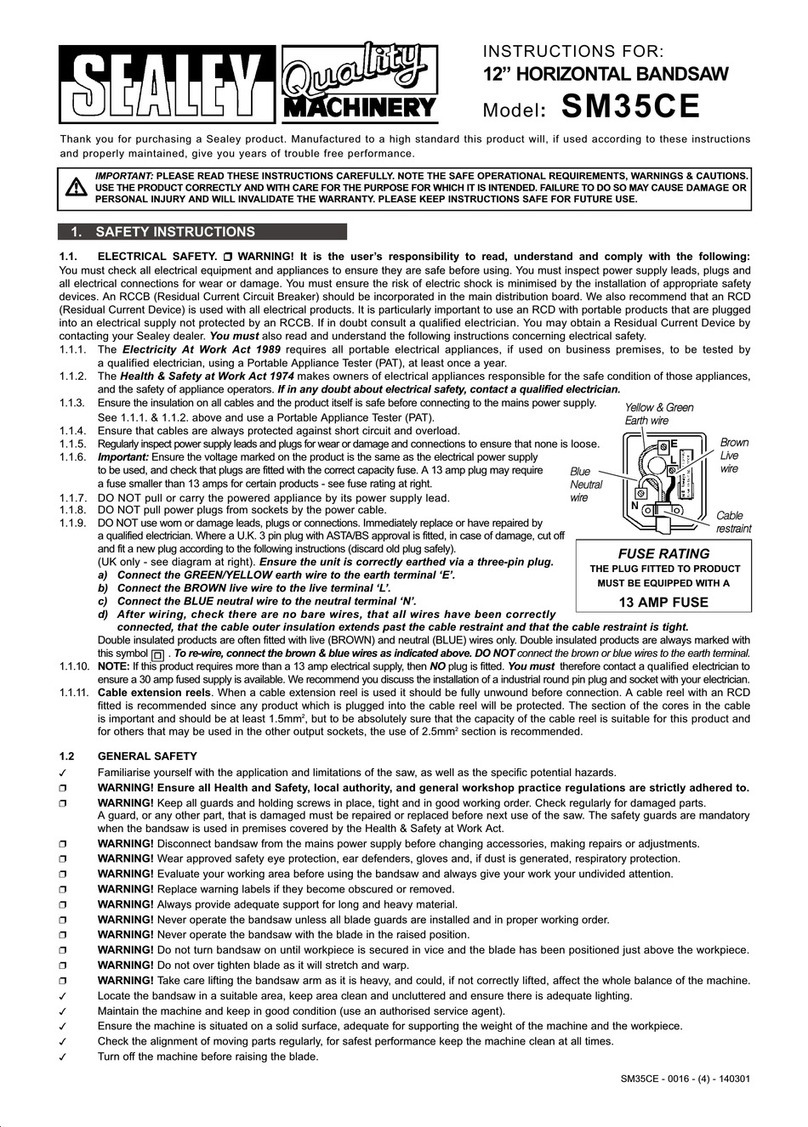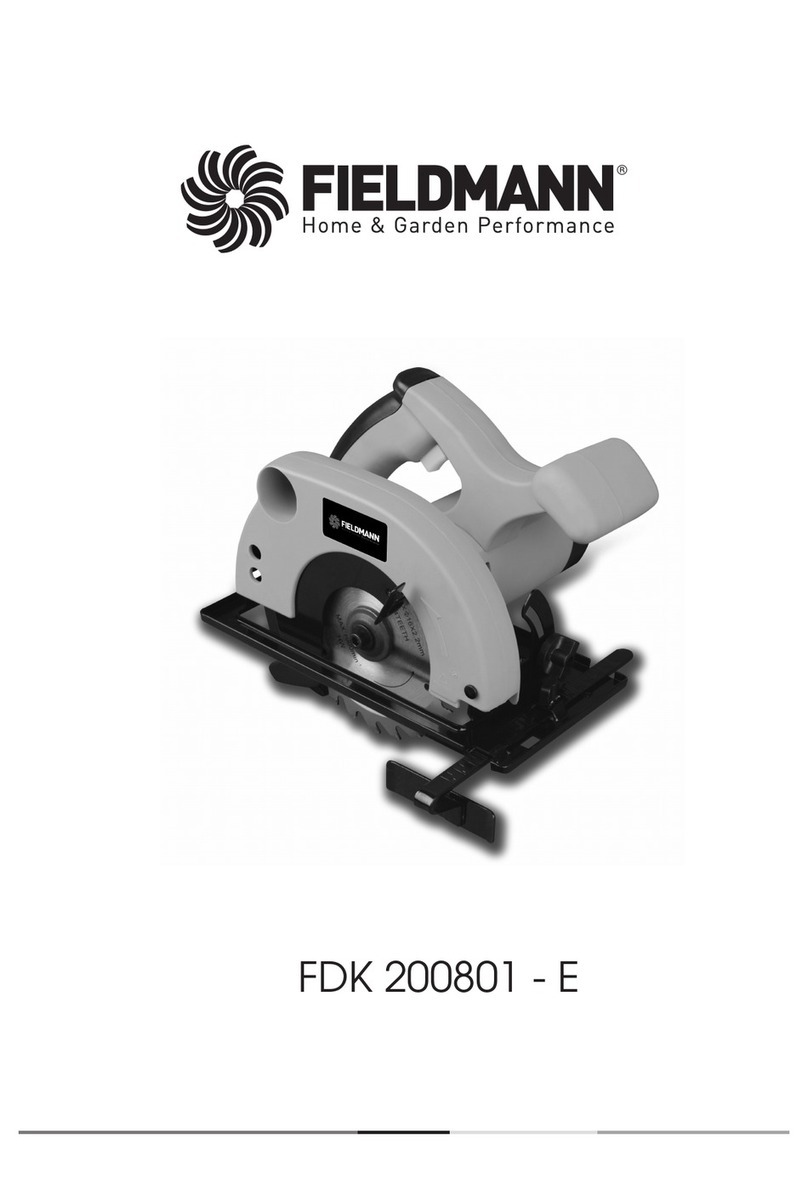Barranca Diamond BD10 Manual

BD10 Power Feed Trim Saw
Owner’s Manual and Operating Instructions
Caution: Read all safety and operating
instructions before using this equipment.
This manual MUST accompany the
equipment at all times.
Revision 109
Manual Part # 169351
03.2014
Barranca Diamond Products, Inc.
1315 Storm Parkway
Torrance, CA 90501
Toll-Free: (800) 630-7682
Phone: (310) 523-5867
Fax: (310) 257-3063
www.barrancadiamond.com

2
Thank you for selecting the Barranca Diamond BD10 Trim Saw. We are certain that you will be pleased with
your purchase. Barranca Diamond takes pride in producing top quality products for hobbyists and commercial
lapidary users throughout the world.
This owner’s manual contains information necessary to operate and maintain your BD10 Trim Saw safely and
correctly. Operated correctly, your BD10 Trim Saw should provide you with years of service. Please take the
time to familiarize yourself with the BD10 Trim Saw by reading and reviewing this manual.
If you should have questions concerning your BD10 Trim Saw, please call Barranca Diamond at:
(310) 523-5867 or Toll Free: (800) 365-0085.
SAFETY
Safety Precautions 3
California Proposition 65 Message 6
Electrical Requirements 7
PRODUCT SPECIFICATIONS 9
Oil/Coolant 10
SETUP
Contents 11
Unpacking and Assembly 11
Transport 11
OPERATION AND ADJUSTMENT
Pre-start Inspection 12
Start Up 13-14
Slab Sawing Mode 15
Trim Sawing Mode 16
MAINTENANCE
Cutting Lubricant Replacement 17
V-Belt 18
Power Feed System and Vise 19
Blade Arbor Assembly and Pulleys 19-20
Main Motor 20
Diamond Blade 21
Blade Installation and Removal 22
EXPLODED VIEW AND PARTS LIST
Exploded View & Parts List 24-29
WARRANTY, RETURN, & CUSTOMER SERVICE
Warranty 30-31
Return & Customer Service 32
TABLE OF CONTENTS
BD-10

3
SAFETY PRECAUTIONS
Read and follow all safety, operating and maintenance instructions. Failure to read and follow these
instructions could result in injury or death to you or others. Failure to read and follow these instructions could
also result in damage and/or reduced equipment life. In order to prevent injury, the following safety precautions
should be followed at all times!
READ OWNER'S MANUAL BEFORE USE
Before using this equipment, ensure that the person operating this machine has read and understands all of
the instructions in the manual. Precaution is the best insurance against accidents. Read and understand all
safety precautions, messages, warnings and hazard symbols. You are responsible for your own safety.
ALWAYS USE SAFETY GLASSES
Safety glasses should always be worn when working around power tools. In addition, a face, dust mask or
respirator should be worn if a cutting operation is dusty. Everyday eyeglasses only have impact resistant
lenses and may not prevent eye injury-they are NOT safety glasses.
USE PROPER APPAREL
Do not wear loose clothing, gloves, neckties, rings, bracelets, or other jewelry that may be caught in moving
parts. Non-slip footwear is recommended. Wear protective hair covering to contain long hair. Hand protection
(plastic gloves) and a shop bib are recommended during sawing to prevent stains to clothing. Avoid prolonged
exposure of skin to the sawing lubricant and wash skin immediately after contact. Do not touch the work
material until the motor is off and the machine has come to a complete stop.
ALWAYS USE HEARING PROTECTION
To reduce the possibility of hearing loss, always use hearing protection when operating power equipment.
KEEP GUARDS IN PLACE
In order to prevent injury, never operate the saw with out the guards in place!
REMOVE ADJUSTING KEYS AND WRENCHES
Form a habit of checking to see that keys and adjusting wrenches are removed from the power tool before it is
turned on.
DO NOT USE IN DANGEROUS PLACE
Do not use power tools in damp or wet locations nor expose them to rain. Always keep the work area well
lighted.
ELECTRICAL SHOCK
Never touch electrical wires or motor components while the motor is running. Exposed, frayed or worn
electrical wiring and plugs can be sources of electrical shock that could cause severe injury or burns. Use a
GFCI (Ground Fault Circuit Interrupter Switch) with the unit. Attach GFCI to the main motor power cord plug
(male) and keep plugged into the power receptacle outlet source.
DISCONNECT TOOLS
Power tools should always be disconnected before servicing or when changing accessories, such as blades,
bits, cutters, and the like.
REDUCE THE RISK OF UNINTENTIONAL STARTS
Make sure the ON/OFF switch is in the OFF position before plugging in a power tool.
BD-10 SAFETY

4
ROTATING OR MOVING PARTS
Keep hands, feet, hair, and clothing away from all moving parts to prevent injury. Never operate the saw with
covers, shrouds, or guards removed.
MAINTAIN TOOLS WITH CARE
Keep tools clean for the best and safest performance. Always follow maintenance instructions for lubricating,
and when changing accessories.
KEEP WORK AREA CLEAN
Cluttered work areas and benches invite accidents.
DO NOT USE IN DANGEROUS OR HAZARDOUS ENVIRONMENTS
Do not operate equipment in dangerous or hazardous environments. Do not use power tools in damp or wet
locations nor expose them to rain. Always keep the work area well lighted. Always work in a well ventilated
area.
KEEP CHILDREN AWAY
All visitors and children should be kept a safe distance from the work area. Keep power cords disconnected
when tool is not in use.
MAKE THE WORKSHOP KID PROOF
Make the workshops kid proof by using padlocks, master switches and by disconnecting all power cords.
USE THE SAW CORRECTLY
Do not force saw, to do a job that it was not designed to do.
SECURE WORK
Clamps or a vise should be used to hold work whenever practical. Keeping your hands free to operate a
power tool is safer.
DO NOT FORCE THE SAW
A power tool will do a job better and safer operating at the rate for which it was designed.
USE THE RIGHT TOOL TO SERVICE THE SAW
Do not force saw or an attachment when servicing or operating this power tool. Use the correct tools for
service or adjustments.
DO NOT OVERREACH
Keep proper footing and balance at all times.
DO NOT OPERATE SAW WHEN TIRED
When tired, take a break and relax.
BD-10 SAFETY

5
DIRECTION OF FEED
Always feed work into a blade or cutter in the direction shown in this manual. All blades, grinding wheels or
polishing belts should always be installed such that rotation is in the direction of the arrow imprinted on the
blade, wheel or belt.
ONLY OPERATE AT THE PROPER SPEED
Severe personal injury and damage to the motor or equipment can result if operated at speeds above
maximum.
NEVER LEAVE SAW RUNNING UNATTENDED – TURN POWER OFF
Do not leave a tool until it comes to a complete stop. Always turn the saw off and disconnect the power cord to
its source when leaving the work area or when work is finished. Do not leave extension cords attached to the
power cord or power receptacle (wall outlet) when leaving the work area.
CHECK FOR DAMAGED OR WORN PARTS
Before using a power tool, check for damaged parts. A guard or any other part that is damaged should be
carefully checked to determine if it would operate properly and perform its intended function. Always check
moving parts for proper alignment or binding. Check for broken parts and mountings and all other conditions
that may affect the operation of the power tool. A guard, or any damaged part, should be properly repaired or
replaced.
USE RECOMMENDED ACCESSORIES AND PARTS
Consult the owner’s manual for recommended accessories and parts. Using improper parts and accessories
may increase the risk of personal and/or bystander injury.
USE THE PROPER EXTENSION CORD
If using an extension cord make sure it is in good condition first. When using an extension cord, be sure to
use one heavy enough to carry the current your product will draw. An undersized cord will cause a drop in line
voltage that will result in a loss of power and overheating. The table on page 8, shows the correct AWG size
to use depending on cord length and nameplate ampere rating. If in doubt, use the next heavier gage. The
smaller the gage number, the heavier the cord.
USE A GROUND FAULT CIRCUIT INTERRUPTER
Use of a Ground Fault Circuit Interrupter between the end of power cord and wall outlet is required at all times.
USE THE PROPER POWER SOURCE
If saw is to be used with a 120 volt 60 HZ power source, ensure power source is at least 15 amps and 110 to
120 volts. Low voltage current can adversely effect electric motor performance and overall life.
If saw is to be used with 220 volt 50/60Hz power source ensure power source is at least 10 amps.
USE THE RECOMMENDED COOLING AND LUBRICATING FLUIDS
Never operate a tool that requires coolant or lubricate dry. This can lead to shortened tool life, tool damage and
personal injury.
MAINTAIN SAW WITH CARE
Keep the diamond blade sharp, the sawing lubricant clean and reservoir filled to the correct level for the best
and safest performance. Always follow the maintenance instructions for sharpening the blade, lubricating and
servicing the BD10.
BD-10 SAFETY

6
BD-10 SAFETY
WARNING
CALIFORNIA PROPOSITION 65 MESSAGE
SILICA DUST WARNING
Grinding/cutting/drilling of masonry, concrete, metal and other materials with silica in their composition may
give off dust or mists containing crystalline silica. Silica is a basic component of sand, quartz, brick clay, gran-
ite and numerous other minerals and rocks. Repeated and/or substantial inhalation of airborne crystalline
silica can cause serious or fatal respiratory diseases, including silicosis. In addition, California and some other
authorities have listed respirable crystalline silica as a substance known to cause cancer. When cutting such
materials, always follow respiratory precautions.
Use appropriate NIOSH-approved respiratory protection where dust hazard may occur. Paper masks or surgi-
cal masks without a NIOSH approval number are not recommended because they do little to protect the work-
er. For more information about respirator programs, including what respirators have received NIOSH approval
as safe and effective, please visit the NIOSH website at:
http://www.cdc.gov/niosh/topics/respirators
Observe OSHA regulations for respirator use (29 C.F.R.§1910.134 and §1503.1).
Visit http://www.osha.gov for more information.
ON
(
(
))
Sawing, grinding and drilling generate dust. Excessive airborne particles may cause irritation to eyes, skin and
respiratory tract. To avoid breathing impairment, always employ dust controls and protection suitable to the
material being sawed or drilled; See OSHA (29 CFR Part 1910.1200).
Some dust created by power sanding, sawing, grinding, drilling, and other construction activities contain chemi-
cals known (to the State of California) to cause cancer, birth defects or other reproductive harm. Some exam-
ples of these chemicals are:
• Lead, from lead-based paints
• Crystalline silica from bricks, cement and other masonry products
• Arsenic and chromium, from chemically treated lumber
For further information, consult the following sources:
http://www.osha.gov/dsg/topics/silicacrystalline/index.html
http://www.cdc.gov/niosh/docs/96-112/
http://oehha.ca.gov/prop65/law/P65law72003.html
http://www.dir.ca.gov/Title8/sub4.html
Your risk from these exposures varies depending on how often you do this type of work. To reduce your expo-
sure to these chemicals, work in a well-ventilated area, and work with approved safety equipment, such as dust
masks that are specially designed to lter out microscopic particles. Where use of a dust extraction device is
possible, it should be used. To achieve a high level of dust collection, use an industrial HEPA vacuum cleaner.
Observe OSHA 29 CFR part 1926.57 and 1926.103.

7
ELECTRICAL REQUIREMENTS AND GROUNDING INSTRUCTIONS
In order to prevent potential electrical shock and injury, the following electrical safety precautions and symbols
should be followed at all times!
In case of a malfunction or breakdown, grounding provides a path of least resistance for electric current to
reduce the risk of electric shock. This tool is equipped with an electric cord having an equipment-grounding
conductor and a grounding plug. The plug must be plugged into a matching outlet that is properly installed and
grounded in accordance with all local codes and ordinances.
• Do not modify the plug provided – if it will not fit the outlet; have the proper outlet installed by a qualified
electrician
• Improper connections of the equipment-grounding conductor can result in a risk of electric shock. The
equipment-grounding conductor is the insulated conductor that has an outer surface that is green, with or
without yellow stripes. If repair or replacement of the electric cord or plug is necessary, do not connect the
equipment-grounding conductor to a live terminal
• Check with a qualified electrician or service personnel if the grounding instructions are not completely
understood, or if in doubt as to whether the tool is properly grounded
• Use only 3-wire extension cords that have 3-prong grounding plugs and 3-pole receptacles that accept the
tool’s plug
• Repair or replace a damaged or worn cord immediately
This tool is intended for use on a circuit that has an outlet that looks like the one shown in Sketch A of the
table below. The tool has a grounding plug that looks like the plug illustrated in the table below. A temporary
adapter, which looks like the adapter illustrated in Sketches B and C, may be used to connect this plug to a
2-pole receptacle as shown in Sketch B, if a properly grounded outlet is not available. The temporary adapter
should be used only until a properly grounded outlet can be installed by a qualified electrician. The green-
colored rigid ear, lug, and the like, extending from the adapter, must be connected to a permanent ground such
as a properly grounded outlet box.
Note: Use of a temporary adapter is not permitted in Canada
To reduce the risk of electrocution, keep all connections dry and off the ground.
A Ground Fault Circuit Interrupter (GFCI) should be used
on the circuit(s) or outlet(s) to be used for this power tool.
Receptacles are available having built-in GFCI protections
and should be used for this measure of safety.
When using an extension cord, the GFCI should be installed
closest to the power source, followed by the extension cord
and lastly, the saw.
Grounding Pin
Grounding Pin
(A)
(C)
(B)
(D)
ADAPTER
Grounding
Means
Metal Screw
Cover of Grounded
Outlet Box
Figure 1
BD-10 SAFETY

8
To avoid the possibility of the appliance plug or receptacle getting wet, position the saw to one side of a wall
mounted receptacle. This will prevent water from dripping onto the receptacle or plug. A “drip loop,” shown
should be arranged by the user to properly position the power cord relative to the power source.
The “drip loop” is that part of the cord below the level of the receptacle, or the connector, if an extension cord
is used. This method of positioning the cord prevents the travel of water along the power cord and coming in
contact with the receptacle.
If the plug or receptacle gets wet, DO NOT unplug the cord. Disconnect
the fuse or circuit breaker that supplies power to the tool. Then unplug and
examine for presence of water in the receptacle.
Use only extensions cords that are intended for outdoor use. These extension
cords are identified by a marking “Acceptable for use with outdoor appliances;
store indoors while not in use.” Use only extension cords having an electrical
rating not less than the rating of the product. Do not use damaged extension
cords. Examine extension cords before using and replace if damaged. Do not
abuse extension cords and do not yank on any cord to disconnect. Keep cords
away from heat and sharp edges. Always disconnect the extension cord from
the receptacle before disconnection the product form the extension cord.
To reduce the risk of electrocution, keep all connections dry and off the ground. Do not touch the plug with wet
hands.
Use of under size extension cords result in low voltage to the motor that can result in motor burnout and
premature failure. Barranca Diamond warns that equipment returned to us showing signs of being run in a
low voltage condition, through the use of undersized extension cords will be repaired or replaced totally at the
customers expense. There will be no warranty claim.
Drip Loop
BD-10 SAFETY
To choose the proper extension cord,
• Locate the length of extension cord needed in Table below.
• Once the proper length is found, move down the column to obtain the correct AWG size
required for that length of extension cord.
EXTENSION CORD LENGTH
Nameplate
Amperes
115V 25' 50' 75' 100' 150' 200'
250V 50' 100' 150' 200' 300' 400'
0 - 5 16 16 16 14 12 12
5.1 - 8 16 16 14 12 10 •
8.1 - 12 14 14 12 10 • •
12.1 - 15 12 12 10 10 • •
15.1 - 20 10 10 10 • • •

9
Main Motor Leeson A4SI7DR56
Horsepower 1/3 HP
Motor Voltage 115 volt/60Hz / 220 volt/50Hz
Amperage 5.8 Amps / 3.5 Amps
Motor RPM 1725 RPM Fixed / 1425 RPM
Blade Shaft 5/8"
Duty Continuous
Motor Arbor Bearings Ball Bearings, permanently sealed
Arbor Diameter 5/8"
Blade Capacity 8", 9" or 10" diameter
Dimensions L x W x H 27" x 17" x 19"
Power Feed Motor REX
Horsepower 1/15 HP
Motor Voltage 110 volt/60Hz / 230 volt / 50/60Hz
Motor RPM 5 RPM (full load) Fixed
Torque 50 inch-lbs.
Rotation Clockwise facing the shaft
Motor Arbor Diameter 5/16"
Motor Arbor Bearings Sleeve-bushing type, permanently sealed
POWER FEED TOGGLE SWITCH CONTROL POSITIONS
1. ON/POWER FEED Position – Provides power from the main motor to the blade arbor and power feed motor.
2. OFF Position – Both power feed and main motors off.
3. MANUAL FEED position - Provides power from the main motor to the blade arbor.
Blade Arbor Bearings: Permanently sealed 5/8" OD shaft ball bearings press fit into aluminum housing (must be
ordered with aluminum housing as an arbor assembly when bearings are worn out.)
Blade Arbor Flanges: Aluminum, 2" OD x 5/8" bore.
Power Feed Threaded Rod: 18" long x 3/8"-24 left hand thread stainless steel rod.
Power Feed Clutch Block: Two piece: silicon bronze half-threaded 3/8"-24 thread friction block.
Rock Vise Capacity: 3-1/4". (Maximum opening between clamping studs)
Cross Feed Index Movement per Revolution of Handle: 1/16".
Power Feed In-Feed Vice Advancement Rate: approximately 3/16 of an inch per minute.
Blade Lubricant Requirements: 0.31 gallon of oil to adequately cover the bottom of a 10” blade and 0.62 gallon
for an 8” blade (Fig. 2).
Shipping Weight 80 lbs. crated (70lbs. uncrated)
Depth of Cut 3" manual feed, 2-5/8" with vise
Oil Capacity 10" Blade, 0.31 gallon; 8" blade 0.62 gallon
BD-10 SPECIFICATION

10
BD10 OIL/COOLANT
Roc Cut
Roc Cut from Diamond Pacic is a new synthetic water soluble cutting additive with rust inhibitors. Mix 30 to 1 (water to
Roc Cut).
Never run a diamond blade dry as this can immediately damage your blade. Use one of the oils/coolants recommended
below. Coolant should be kept clean and below 100° F. Sludge should be removed periodically and replaced with fresh
coolant so that your cuts will be clean and your blades will not be damaged.
Non-hazmat replacement oil for electrical transformer cooling. Excellent lubricating properties for blades and saw parts.
Flushes sludge from rock easily, degreases easily, and sludge settles in saw tank well. In Southern California, Shell Diala
Ax can be purchased from Dion and Sons, Inc (www.dionandsons.com).
Food grade mineral oil. Non-hazardous lubricating oil for bakeries, breweries and food processing machinery. Good lubri-
cating properties, degreases and settles sludge well. Can go rancid over time (1 year or less).
Food grade mineral oil, excellent for slab sawing in all our slab saws.
Pure petroleum based machining cutting oil. Good for slab sawing but very strong odor. Often the cheapest priced oil
available but odor is tough to eliminate.
Ethylene glycol based automotive antifreeze and its vapors are considered hazardous and toxic. Propylene glycol based
antifreeze is nontoxic but has practically no lubricating properties; it functions as a coolant only and its use will lead to
rapid blade wear and dulling.
Does not have adequate lubricating proprieties for our saws; vapors are considered hazardous and toxic.
A good coolant but has no lubricating properties and causes rust and degradation of exposed iron and steel parts. Causes
rapid blade dulling and premature wear. Use of water voids the warranty on all Barranca Diamond saws.
Water soluable synthetic coolants (i.e. Valenite or Cimtool) are often mixed in a 20:1 blend with water. Fluid vapors are
considered hazardous. These uids do not have adequate lubricating or rust inhibiting properties for the cast iron and
steel parts in our slab and trim saws.
Very ammable with a low ash point. At least 3 of our commercial cutting customers in Arizona and Pacic Northwest
have burned down their shops using these uids. Can be very tough to degrease the residue and aroma out of the cut
slabs. These uids are cheap, but very hazardous to use. Diesel is a benzene compound which is carcinogenic. All these
uids can cause severe skin rashes and other ailments.
Shell Diala Ax and Amber Neutral 100
Chevron Superla #5
AVATEC 80
Texaco ALMAG
Automotive Antifreeze Coolant
Automotive Transmission Fluid
Water
CNC Machining Fluids
Diesel, Heating Oil and Kerosene
Electrical transformer cooling oil. A highly rened petroleum product, available from some non-Shell oil distributors, typi-
cally only in 55 gallon drums. Same properties and performance as Shell Amber Neutral 100.
Hyvolt II
A chlorine-free cutting oil with reduced sulfur and fat content. Light in color and low in odor.
Chevron Texaco Bright-Cut
Roc-Oil
Roc-Oil from Diamond Pacic is an oil coolant for heavy duty cutting. Provides excellent blade protection and will not
cause rust to your blade or saw.
Under NO circumstances should any of the following fluids be used in any of our lapidary saws:
RECOMMENDED CUTTING OILS

11
BD10 SETUP
TRANSPORT
For ease of transport, place the hood over the saw table and tape the hood to the table. All sawing lubricant
should be removed from the reservoir during transport of the saw.
A. Belt Guard
B. Drain Hose
C. Hood
D. Power Toggle Switch
E. Blade Guard
A. Table
B. Clutch Plates
C. Rock Vise
D. Crossfeed adjustment knob
E. Clutch plate engagement locking knob
F. Vise rotation locking knob
G. Shut off rod adjustment
CONTENTS
In the shipping crate, you will find one Barranca Diamond BD10 Trim Saw assembly (saw, motor, baseboard,
spray hood and ten inch lapidary diamond blade).
UNPACKING AND ASSEMBLY
Your BD10 Trim Saw has been shipped from the factory thoroughly inspected and tested. Remove the crating
material (wood and plastic) from the baseboard and around the saw. Remove the spray hood from the saw and
remove the protective covering.
A
B
D
C
E
A
B
F
E
D
G
COMPONENT LOCATION

12
BD10 OPERATIONS AND ADJUSTMENTS
PRE-START INSPECTION
Place the BD10 Trim Saw on a flat surface such as a bench top or table. Set the toggle power switch to the
MIDDLE/OFF position (Fig. 1).
Fig. 2. Cutting lubricant level should
cover the bottom 1/4" of the blade
Fig. 1. OFF position
Fig. 3. Unlock table Fig. 4. Lifting table Fig. 5. Secure sludge plug
1/4"
Prior to operating the BD10 Trim Saw, ensure the sludge plug is secure. Then you must fill the oil reservoir so
that the lubricant fluid covers the bottom 1/4" of the blade (Fig. 2). 0.31 gallon of oil will adequately cover the
bottom of a 10” blade and 0.62 gallon will be sufficient for an 8” blade. Do not overfill the oil reservoir as excess
fluid will result in unnecessary spraying of fluid while sawing and possibly cause damage to the arbor and motor.
Periodically, check the oil level and add oil as some oil is lost due to misting and evaporation while sawing.
To add lubricant, loosen wingnut under table on the table lock down rod. Remove washer (Fig. 3). Ensure wingnut
is aligned with slot (Fig. 4). Lift table up. Ensure sludge plug is securely pushed in before filling (Fig. 5).
NOTE:
FILL RESERVOIR
The blade is manufactured to cut in either a petroleum, mineral or synthetic water soluble oil saw
lubricant. Although water can be used with the BD10 Trim Saw, it is not recommended as the steel
arbor shaft can rust. In addition, poor sawing performance and short blade life can result. If water
must be used, it is recommended that a rust inhibitor such as Tool Cool (8 oz. Tool Cool to 1 gallon
water) be added.

13
Fig. 5. Secure sludge plug
START UP
Inspect the belt tension. Check the four motor mounting bolts (Fig. 6) to ensure they are tight and the motor
is secure. The V-belt is adjusted and tensioned at the factory. If belt needs adjustment, loosen nut (Fig. 8).
Tighten or loosen screw (Fig. 9) until belt is properly tensioned. There should be no more than 1/2" of belt
deflection when the belt is depressed by fingertip pressure (Fig. 7).
Fig. 6. Motor mounts bolts
Fig. 9. Adjust screw
Fig. 10. Loosen clutch plate Fig. 11. Rock vise
Fig. 7. V-belt correctly tensioned Fig. 8. Loosen nut
To perform a power up test on the BD10, first disengage the vise clutch by turning the knob counterclockwise
to loosen the clutch plate (Fig. 10). Move the vise to the front (operator's) end of the saw table (Fig. 11).
START UP
When you have confirmed that the belt is properly tensioned and the motor mounting bolts are secured. You
are ready to proceed. Be sure the proper amount of lubricant is in the reservoir. Check to ensure that the toggle
power switch is in the MIDDLE/OFF position.
BD10 OPERATIONS AND ADJUSTMENTS

14
START UP
Lock the clutch plates by turning the knob clockwise (Fig. 12). Be sure to securely tighten the knob on the vise as
well (Fig. 17). Now engage the power feed toggled RIGHT/ENGAGED FEED position and main motor to begin
advancing the vise and rotating the blade (Fig. 13). The power feed motor will slowly move the vise toward the
blade (approximately 3/16 of an inch per minute). The saw hood does not need to be placed over the saw table
during this power test. Once you have confirmed the vise is moving toward the blade and the blade is turning,
this indicates the saw is functioning properly. The saw can be turned off by flipping the toggle switch to the
MIDDLE/OFF position (Fig. 14).
Fig. 12. Lock clutch plate Fig. 13. Power feed toggle Fig. 14. OFF Position
SLAB SAWING MODE
To begin slabbing of rock material, turn the toggle switch to the MIDDLE/OFF (Fig. 14) position and secure the
material in the rock vise by opening the vise jaws wide enough to fit the material to be cut (Fig. 15). Retighten
the jaws with the wing nut screws on the rock vise (Fig. 16). The material in the vise should be positioned close
to (but not touching) the diamond blade. Disengage (loosening) the clutch plate by turning the knob counter-
clockwise (Fig. 10). Move the vise forward toward the blade.
Fig. 15. Open rock vise Fig. 16. Material positioned in vise near
blade prior to cutting
Fig. 17. Vise adjustment
Fig. 18. Vise cross-feed locking
Once the vise is positioned close to the blade, loosen the knob on the
vise (Fig. 17) and laterally move the vise to the desired slab thickness
to be cut by turning the cross-feed knob (Fig. 18) clockwise or counter-
clockwise. Retighten the knob on the vise.
BD10 OPERATIONS AND ADJUSTMENTS

15
Fig. 17. Vise adjustment
Fig. 18. Vise cross-feed locking
SLAB SAWING MODE
At this point, the clutch should be engaged by turning the knob clockwise (Fig. 12). The hood may be placed
over the table to contain spray and misting. Slabbing of material can now be initiated by engaging the power
feed and blade by moving the toggle switch to the RIGHT/ENGAGED FEED position (Fig. 13). The rock vise
and material will move forward into the blade and the slab will be cut from the vised material. The vise will
proceed to move along the power feed rail until the automatic feed shut-off rod is engage by the powerfeed box
contact switch. Once the shut-off-rod encounters contact, the powerfeed box will shut off by contact with the
switch. Before pulling the vise back, move the power toggle switch to the MIDDLE/OFF position (Fig. 14).
The shut-off rod can be adjusted to any position along the length of the 1/4" rod by loosening the knob on the
carriage (Fig. 19) and sliding the rod to the desired position (Fig. 20) and retightening adjustment knob. After
the slab has been cut and the power feed is shut down automatically, the user can reposition the rock vise to
the next position in front of the blade. Move the power toggle switch to the MIDDLE/OFF position. Adjust the
vise to begin the next slab cut by disengaging the clutch and sliding the rock vise to a position in front of the
blade again. Once the clutch is reengaged by turning the knob clockwise, the next slab can be cut.
Position the plastic splash hood onto the table (Fig. 21) so that spray from the cutting fluid (oil or water) dur-
ing sawing will be contained and drain back into the reservoir. Excess cutting fluid that builds up on the table
during slab or trim sawing will drain back into the reservoir through the blade slot and drain hole adjacent to the
slot. Rock chips and debris from sawing should be removed from the table area periodically to prevent interfer-
ing with free movement of the vise over the table during automatic or manual feeding.
Fig. 19. Shut-off adjustment knob
Fig. 21.
Fig. 20. Shut-off rod
WARNING: If you do not move the toggle switch to the MIDDLE/OFF position before moving the vise back,
the motor and blade will restart.
BD10 OPERATIONS AND ADJUSTMENTS

16
Fig. 22. Manual feed position
Fig. 23. Loosen vise Fig. 24. Rotate vise up
TRIM SAWING MODE
Slabbing of rock material to uniform thicknesses using the BD10 Trim Saw is best performed using the auto-
matic power feed mode. However, manual trimming of slabs to desired shapes (preforming) can be achieved
using the saw in the LEFT/MANUAL FEED position (Fig. 22).
To use this mode, first place the toggle in the MIDDLE/OFF position (Fig. 9) and flip the vise assembly over the
cross feed rail by removing the knob on hinged portion of the vise (Fig. 23) and rotating the vise so that it pivots
off the saw table (Fig. 24). At this point the saw is ready to be used in the manual mode (with only the blade
motor activated) for manual trimming of slabs by placing the toggle in the LEFT/MANUAL FEED position.
BD10 OPERATIONS AND ADJUSTMENTS

17
The rock slab to be trimmed should rest flat and firmly on the saw table in
front of the blade prior to moving the toggle switch to the LEFT/MANUAL
FEED position. The user should use light but firm pressure to cut the slab
in the manual mode letting the blade do the work and not force the slab
into the blade.
The blade guard height can be adjusted by turning the thumb knob at the
rear mounting position of the guard. Under no circumstances should the
blade guard be removed. While the blade guard will reduce excessive
splash and spray of cutting fluid during rock trimming, it is advised to wear
personal protective gear (safety glasses, gloves and a shop bib) during
manual mode trimming.
CUTTING LUBRICANT REPLACEMENT
The BD10 Trim Saw requires periodic routine maintenance to remove the build up of rock mud (sludge) and
dirty lubricating fluid from the reservoir. It will be apparent to the user that the lubricating fluid is dirty and
needs to be changed if the oil residue on the saw table after cutting is thick and dark with rock sludge build up.
The oil liquid can be removed rapidly using the drain hose at the base of the oil reservoir (Fig. 26).
A five gallon bucket or collection container can be placed under the outlet cap and the cap removed with an
adjustable wrench to let the oil flow free into the bucket for proper disposal. The sludge residue will likely not
flow through the drain hose and will remain inside the oil reservoir, therefore, the sludge should be removed by
hand. Extract the sludge with a spatula or spoon out of the bottom tank hole. With motor side secure on table
top, move hole over table edge and remove plug (Fig. 27). Sludge can be put through the hole for removal.
Once the sludge is removed, wipe clean the inside of the tank with a disposable towel. Replace sludge plug
and hose cap and refill with cutting lubricant to cover the bottom 1/4" of the blade (Fig. 2). Be sure to check
the fluid level of the cutting lubricant inside of the oil reservoir after every 2 to 3 hours of use. The fluid will
be absorbed onto the rock material, combine with rock mud (sludge) and be lost due to heat misting and
evaporation.
Fig. 26. Drain hose
Fig. 25. Blade guard adjustment
Fig. 27. Sludge plug
BD10 OPERATIONS AND ADJUSTMENTS

18
Fig. 28. Remove belt guard Fig. 29. Belt tension Fig. 30. Adjusting belt tension
V-BELT
The BD10 Trim Saw blade arbor is powered by an AX-27 rubber V-belt from the electric motor. The V-belt is
correctly tensioned at the factory. However, if it is necessary to service the belt, unplug the BD10 Trim Saw
from its power source and remove the fasteners which secure the belt guard housing (Fig. 28). If the belt
tension should become too loose, poor sawing performance or slipping will result. The belt tension should be
checked periodically by removing the guard and depressing the belt in the middle between the motor and blade
pulleys (Fig. 29).
There should be 1/2" of deflection once the belt is pushed down. If the belt is too tight (i.e. no deflection) the
electric motor and blade arbor bearings may be overheated and wear out prematurely or the motor may shut off
due to overheating. Belt tension can be adjusted by loosening the jam nut and then adjusting the hex head bolt
in the center top of the motor mount plate (Fig. 30). Be sure to replace and attach the belt guard.
POWER FEED SYSTEM AND VISE
The power feed system utilizes a AC gear motor mounted inside of the rectangular box attached to the table of
the BD10 Trim Saw. There is no need to service or lubricate the power feed motor unless the motor fails and
the screw feed rod fails to rotate when the feed is engaged. If the set screw that fastens the power feed motor
to the feed rod loosens during use or shipping, the rod will not rotate and move the vise toward the blade. This
rod set screw can be tightened with a US standard Allen/hex wrench should it loosen.
BD10 MAINTENANCE

19
POWER FEED SYSTEM AND VISE
Periodically the user should apply a thin coat of lubricating grease (wheel bearing or lithium grease) to the
3/8"- 24 screw feed rod to prevent the screw feed rod threads from becoming prematurely worn. If the threads
on both the bronze clutch blocks should become worn or “flattened” the clutch block will not securely engage
with the screw rod and it may disengage from the clutch block and not automatically advance the rock vise. A
replacement bronze clutch blocks can be obtained from Barranca Diamond. The rock vise assembly has cross
feed threads (Fig. 31) attached to an indexing or crank knob to laterally adjust the vise so that slab thickness is
accurately controlled before each slab cut. These threads should be lubricated periodically with wheel bearing
or lithium grease to allow for ease of rotation of the cross feed knob.
BLADE ARBOR ASSEMBLY AND PULLEYS
The BD10 Trim Saw is equipped with a 5/8"- 11 left-hand threaded arbor shaft with sealed ball bearings
mounted in an aluminum bearing arbor housing. A 2" OD x 5/8" bore die cast zinc coated pulley is mounted
on the shaft outside the oil reservoir. Unusual noises emanating from the saw tank or arbor area, slower than
normal cutting speeds and overheating of the shaft or belt are indications of arbor/bearing wear. Using the saw
with a worn arbor/bearing assembly can result in poorly cut rock slabs not to mention permanent damage to
other components of the saw. A new arbor/bearing assembly can be purchased from Barranca Diamond. It is
sold only as a complete unit as the bearings are installed in the aluminum housing by the factory.
Fig. 31. Cross feed adjustment
VISE
Should the wooden jaw on the upper vise become worn or start delaminating, replacement jaws can be made
from 1/2" plywood.
BD10 MAINTENANCE

20
Fig. 32. Blade arbor bolts
BLADE ARBOR ASSEMBLY AND PULLEYS
Periodically, check the tightness of the four blade arbor housing mounting bolts (Fig. 32) to make sure they are
securely tightened to the oil reservoir. Should the 2" OD die cast pulleys on either the motor or blade arbor
shaft need to be removed or replaced, loosen the set screw on the hub of each pulley with a US standard
Allen/hex wrench to remove the pulley from the shaft.
MAIN MOTOR
The BD10 is equipped with a Baldor or Leeson 1/3 HP 1725 RPM single-phase 120 volt 60 Hz 8 amp motor.
The motor shaft has sealed ball bearings and requires no lubrication. The motor is protected from thermal
damage (overheating) with an automatic shut-off switch. If the motor overheats, it will automatically shut off
and restart once its internal components cool down. The Leeson motors now being used have no reset button.
Be sure to shut off the main motor by placing the switch lever to the OFF position and disconnecting the power
source. After allowing the motor to cool (2 to 3 hours), restart the unit by turning the switch to ON. If the motor
does not restart after a cool down period, remove the motor and have an authorized repair service center for
Baldor or Leeson inspect the motor. Barranca Diamond can refer you to an authorized motor repair service
center in your area.
BD10 MAINTENANCE
Export version of BD10 Saw with a 220 volt/50Hz motor available (part # 169201).
Other manuals for BD10
1
Table of contents
Other Barranca Diamond Saw manuals
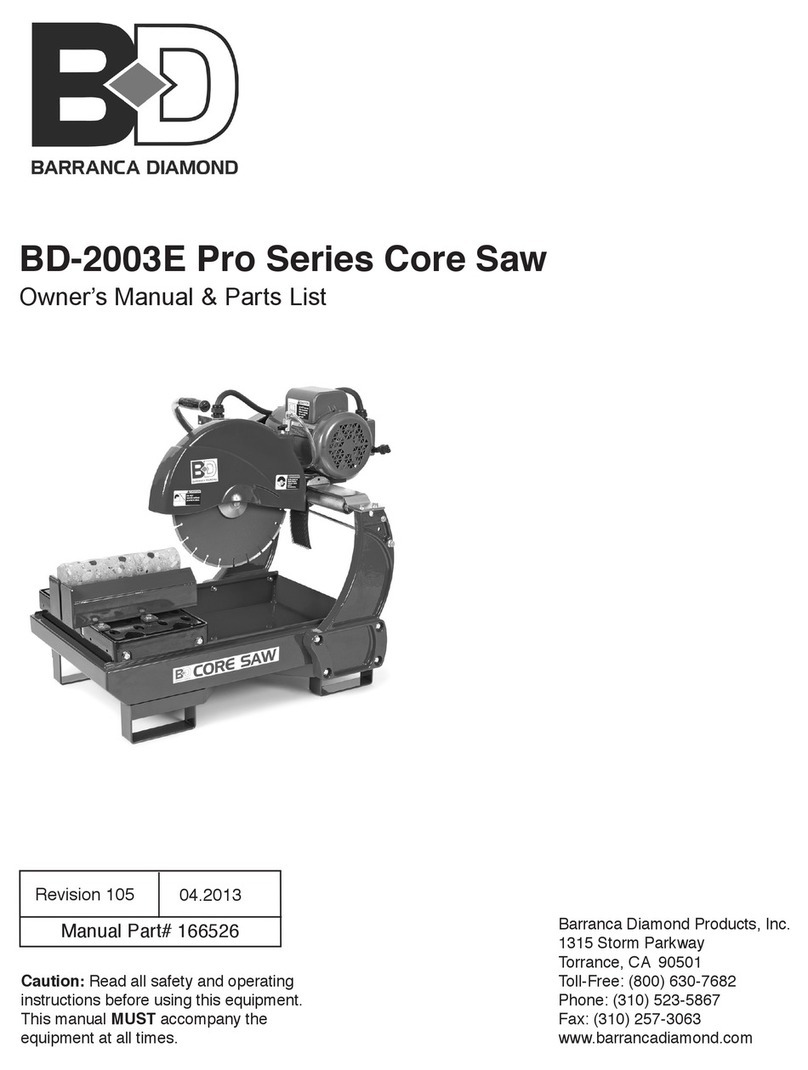
Barranca Diamond
Barranca Diamond BD-2003E User manual

Barranca Diamond
Barranca Diamond HP18-24 User manual
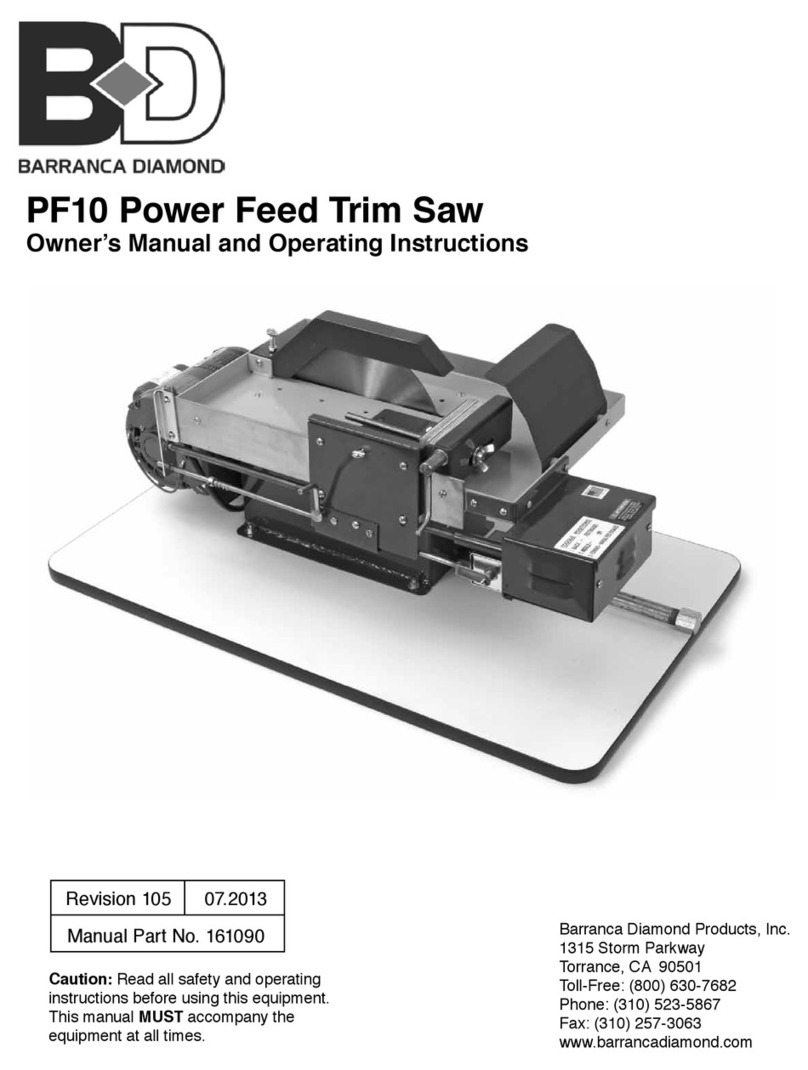
Barranca Diamond
Barranca Diamond PF10 Manual

Barranca Diamond
Barranca Diamond HP18 User manual
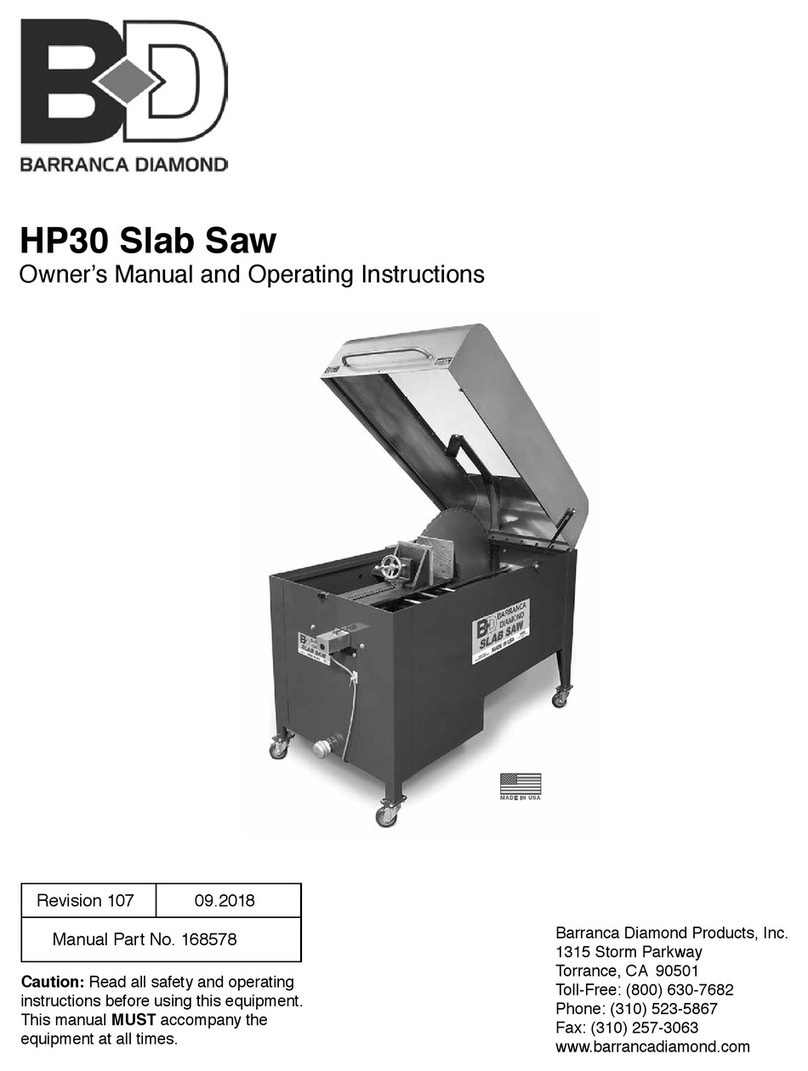
Barranca Diamond
Barranca Diamond HP30 Manual
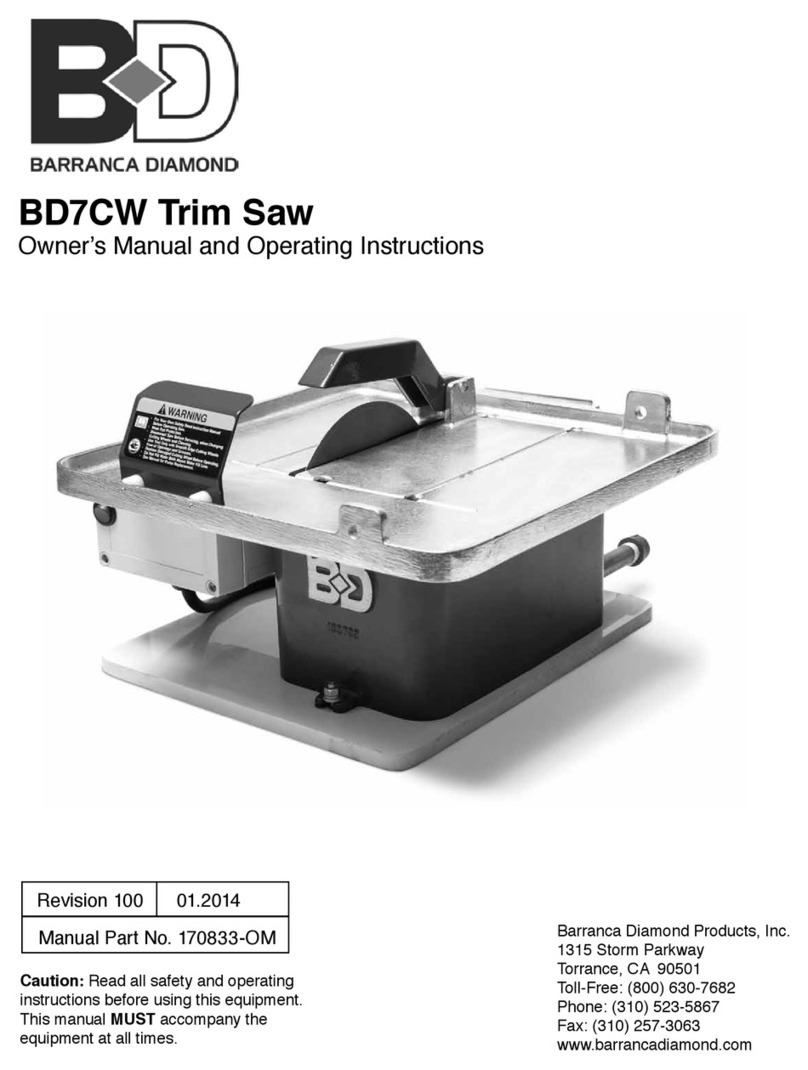
Barranca Diamond
Barranca Diamond BD7CW Manual
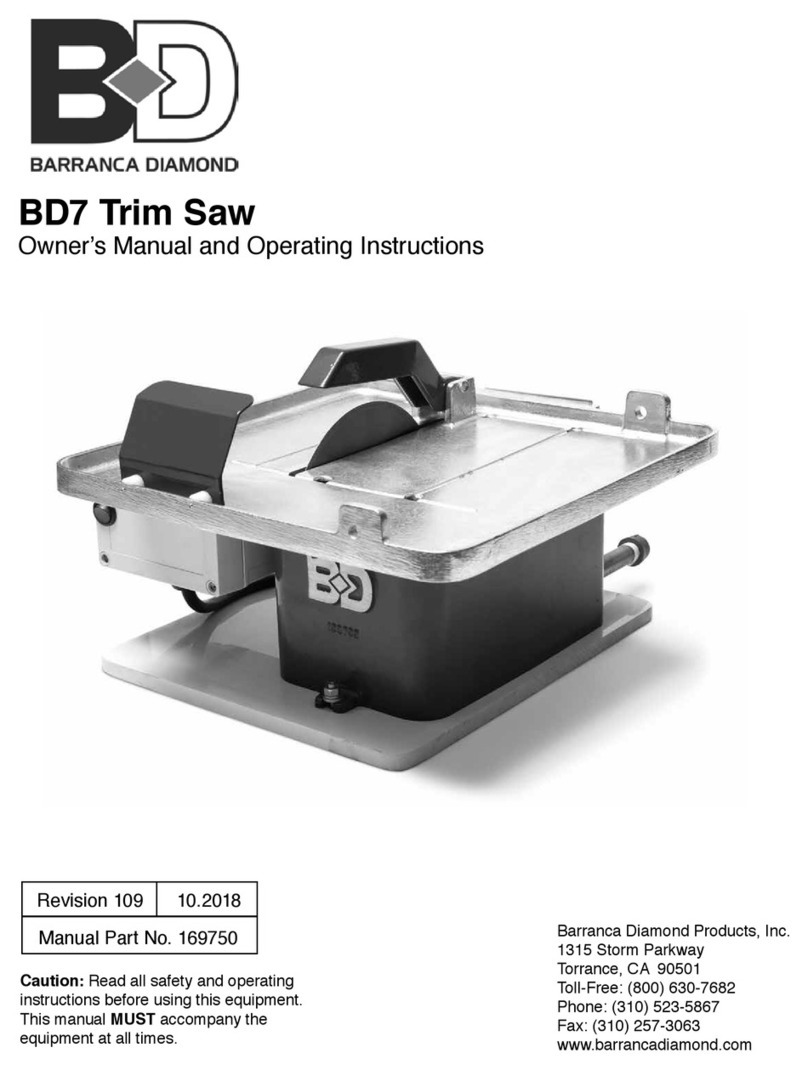
Barranca Diamond
Barranca Diamond BD7 Manual

Barranca Diamond
Barranca Diamond BD10 Manual

Barranca Diamond
Barranca Diamond BD7 Manual
